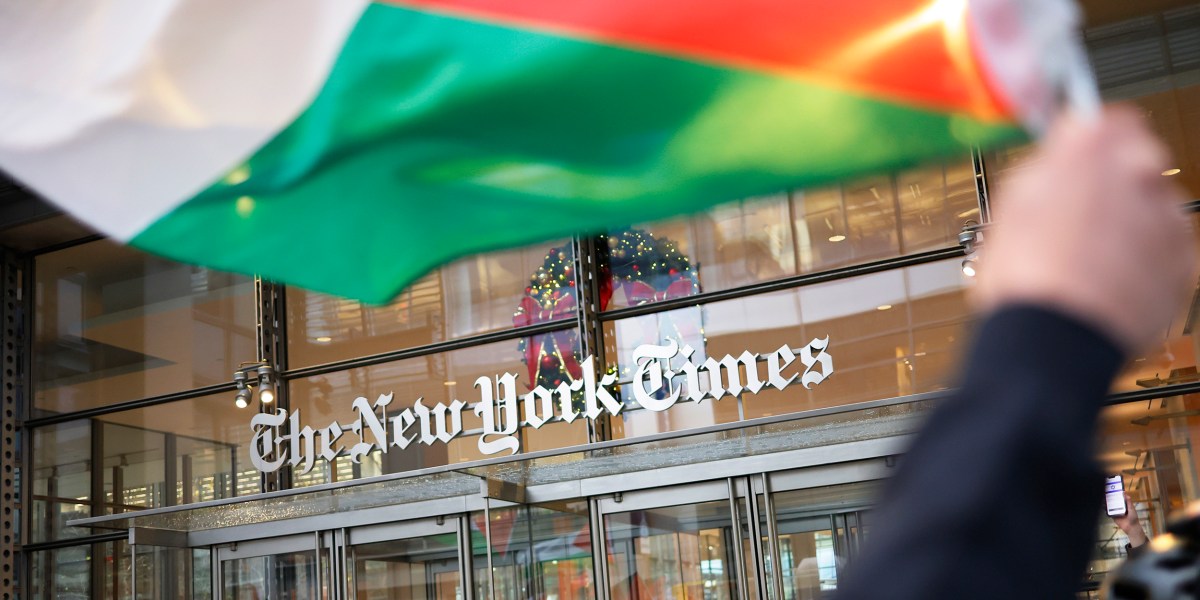The New York Times, Washington Post, and Los Angeles Times’s coverage of Israel’s war on Gaza showed a consistent bias against Palestinians, according to an Intercept analysis of major media coverage.
The print media outlets, which play an influential role in shaping U.S. views of the Israeli–Palestinian conflict, paid little attention to the unprecedented impact of Israel’s siege and bombing campaign on both children and journalists in the Gaza Strip.
Major U.S. newspapers disproportionately emphasized Israeli deaths in the conflict; used emotive language to describe the killings of Israelis, but not Palestinians; and offered lopsided coverage of antisemitic acts in the U.S., while largely ignoring anti-Muslim racism in the wake of October 7. Pro-Palestinian activists have accused major publications of pro-Israel bias, with the New York Times seeing protests Opens in a new tabat its headquarters in Manhattan for its coverage of Gaza –– an accusation supported by our analysis.



I suggest you read the articles, they have graphs and stuff.
I did read the article. I think the methods are questionable. Making a graph doesn’t mean the methods are sound.
For example:
In other words “There have been 20000 Palestinian deaths and 1000 Israeli deaths” is considered biased, and that sentence should have used the word “Palestinian” twenty times because there were twenty times as many deaths.
deleted by creator
The rest of the article is also flawed.
For instance “[the media] mentioned antisemitism more than Islamophobia”. This presupposes that antisemitism should not be mentioned more than Islamophobia. But why?
If I said “The media mentioned Islamophobia more than Francophobia” then that’s not an example of bias, because Islamophobia has been newsworthy for years and nobody pays attention to the French.
So is antisemitism more newsworthy than Islamophobia? Maybe so, given the Stefanik hearings. Maybe not. But the Intercept hasn’t even considered this.
Likewise, they count usage of words like “massacre” and “slaughter”. But what is that supposed to prove? The Intercept presupposes an unbiased source would not associate “massacre” with Hamas more than Israelis, but why?
Finally, the Intercept wonders why “children” is not used more often in reporting. Here’s one possibility: the media treated dead adults and dead children equally, lumping them together in “total dead”. They are not singling groups out in a way that the Intercept would prefer. That’s the opposite of bias.
Thought experiment: if the media constantly reported “X deaths, of whom Y were Christians” wouldn’t that be kind of creepy? Why does someone’s religion even matter when tallying the dead? Well, the same could be said of someone’s age.
deleted by creator
No, the article doesn’t even attempt to measure the rises, much less show that they were similar.
No, the Intercept is again looking for an axe to grind. For example:
Here the Israeli children are uncounted. Is that an example of anti-Israeli bias? No, because despite counting only Palestinian children the media made the mistake of describing their methodology: children are those under 18. Less precise language would be better. Does “children” even appear elsewhere in that article?
Clearly those are Israeli children. No? They are Palestinian? Yeah but this was 10/13 so what about all the mentions of Israeli children still in hospitals? None? The same article only mentions Palestinian “children” in hospitals? Ok, well the Intercept will have to report that as a counterpoint. Just kidding, this is the Intercept after all:
The Intercept is worse than lazy, they think their readers are too dumb to remember the news.
Just the first six hits from just one Google search:
https://www.nytimes.com/2023/11/19/world/middleeast/premature-babies-al-shifa-hospital-gaza-evacuation.html
https://www.reuters.com/world/middle-east/gaza-health-ministry-says-no-objection-moving-babies-no-mechanism-do-so-2023-11-14/
https://www.nbcnews.com/news/world/abandoned-babies-found-decomposing-gaza-hospital-evacuated-rcna127533
https://www.cnn.com/videos/world/2023/11/14/gaza-hospital-al-shifa-supplies-incubators-israel-hamas-war-nada-bashir-dnt-tsr-vpx.cnn
https://www.pbs.org/newshour/world/premature-babies-evacuated-from-shifa-hospital-to-southern-gaza-trauma-patients-remain
https://www.washingtonpost.com/world/2023/12/03/gaza-premature-babies-dead-nasr/
deleted by creator
I don’t insist that, at all. Maybe they do.
I’m just evaluating the Intercept’s methodology, which is garbage. So the article doesn’t persuade me in either direction, and like you I’ll have to do my own research.
I’m unsure what your point is.
This is only in the first six weeks, current bias against Palestinians is even higher.
The Intercept doesn’t report on the deaths. It’s not a classic “news” site in the way these papers are. They mainly break scandals and leaks such as CNN and the IDF Censor .
The Intercept is measuring “bias” by comparing the ratio of Palestinians/Israeli deaths to the ratio of using the words “Palestinian” and “Israeli” in the media.
Which means according to the Intercept, if CNN writes “There have been 20000 Palestinian deaths and 1000 Israeli deaths” then this is another example of bias, because CNN only used “Palestinian” once in that sentence. Which is nonsense.
deleted by creator